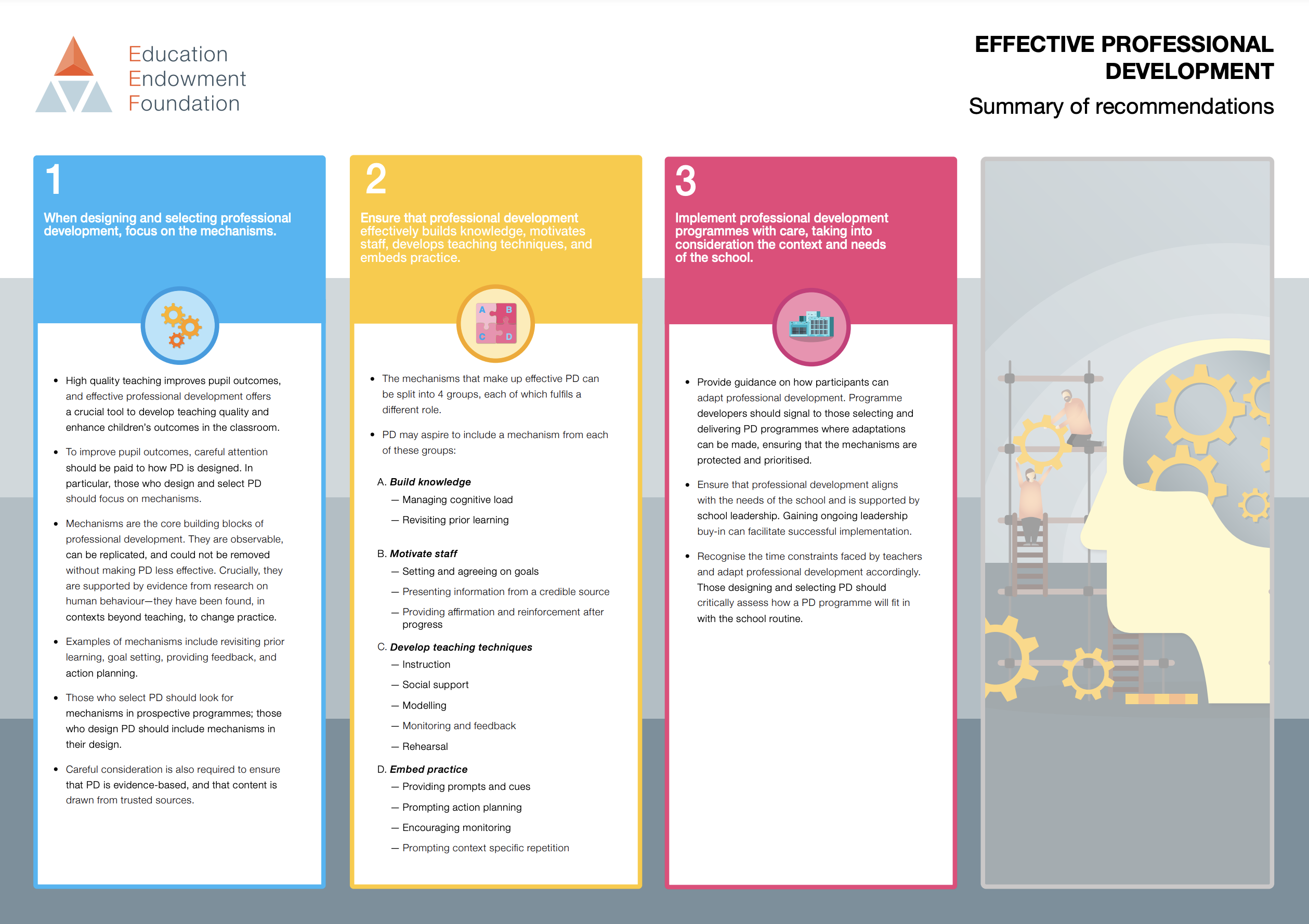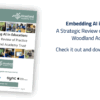
Thankfully, the face of CPD in education (that’s Continuing Professional Development, with the emphasis on the Continuing element) has been changing in recent years.
I’ve always recognised the importance of certain types of INSET activity, such as:
- bringing colleagues together to share whole school data and results when everyone comes back after the summer break; or
- everyone receiving their mandatory EpiPen training
- coming together to learn about the importance of key statutory requirements such as:
- safeguarding best practices,
- how to deal with a safeguarding disclosure scenario,
- how to avoid copyright infringements in reprographics…
…these types of ‘training’ or information dissemination sessions do mostly stand by themselves in their application. When it comes to more ‘meaty’ whole school priorities around teaching and learning development, however, a one-stop Inset day with no follow-up, continuing conversation or any opportunity to reflect and embed the learning often had me questioning ‘why bother’ both when I was in post and subsequently in my role as the person often delivering the content on those kinds of days.
I don’t mind admitting whilst I’ve always shared impactful approaches and bundles of resources for schools to use in an ongoing way, often, it has been these sorts of sessions where the one-day engagement is all that takes place and schools have hoped that it will have a lasting impact and are then surprised when they don’t. In my planning with leadership teams, I always try to advocate with them approaches which involve:
- Regular revisits of learned approaches/strategy and content in meetings such as department meetings or
- Check-ins on how teachers are progressing
- Advocating in the school for a digital champion within a faculty, year group or department
- Follow-up observations in school to explore progress and address misconceptions
- Access to remote check-ins with me as part of the training offer
Some schools take me up on the additional offers and ideas above, some don’t. In my experience, those that embed some of the approaches shared above, tend to have more success than those who don’t, regardless of whether they involve me.
So what?
(Continuing) Professional Development is important, but equally, it is important to remember that teachers will have competing pressures, deadlines, and commitments. Finding time to invest in professional learning is something which needs and should be planned carefully, time be found to support it and afforded and not just in the allocated Inset days across an academic year.
If you want teachers to be able to implement a new approach or strategy, as yourself, “what are you going to take away from them in order to bring in this new approach or strategy, and where are you going to find the time to give them the opportunity to practice it, gain competence and confidence in using it and the cognizance to know when best to deploy it?”
Fortunately, schools are recognising this more and more and quite rightly so. Identifying the benefits that a carefully planned PD approach for colleagues learning at scale is something that the EEF’s superb “What are the Characteristics of Effective Teacher Professional Development? A Systematic Review and Meta-analysis” document does, in some detail.
Some of the mechanisms to support successful CPD shared in the document link to several approaches I’ve worked on in projects I’ve led on.
Factoring time in for social support for example with “access to a peer who has knowledge and experience of the desired behaviour or practice (Dennis, 2003)” is deemed to be a useful mechanism for support. Therefore, building in time for coaching and checking in with such a person is recognised by the sharing that [the] “guidance a peer offers makes behaviour change more likely”.
This is exactly what I do when I offer schools as part of my ongoing support package to offer as mentioned above:
- Follow-up observations in school to explore progress and address misconceptions
- Access to remote check-ins with me as part of the training offer
What else?
Cognitive load was also found to be problematic when it came to delivery, in a similar way to how we find in classroom settings.
In the document, they explain the IGTP (an acronym summarising the four purposes of PD: instil insight, motivate goal-directed behaviour, teach techniques, embed practice.)
Instilling insight is deemed to have, again like how we find in classroom settings with our students, to be best approached by being mindful of cognitive load (mechanism 0.1) and revisiting prior learning (mechanism 0.2). This is useful information both for those involved in delivering any planned PD sessions and those planning and mapping out PD for colleagues across an academic year. As they share, “Those who select PD should look for mechanisms in prospective programmes; those who design PD should include mechanisms in their design.”
How can I avoid cognitive load with content delivery?
One good way I’ve found of reducing cognitive load when delivering training is to plan sessions just as I would for my classes when working with learners.
By keeping content laser-focused, outcome transparent, with clearly stated learning outcomes for learners and bite-sized (no longer than 45 – 60 minutes), I am able to cover in depth the required content to deliver the session.
Sometimes I do this in specific sessions. Here are some examples I recently delivered for a client:
- Practical approaches to collaborative learning within Google Workspace
- Practical approaches to developing peer marking and assessment using Google tools
- Practical ways to support retrieval practice in a blended learning environment
- Practical approaches to collaborative learning within Google Workspace
Each session was planned for 45 minutes, specific and tailored to each of the different topics. Being mindful of drawing on revisiting prior learning, sessions were also developed with discussion with attendees and tempered in-session based upon the attendee’s lived experiences within their classrooms and settings, with concrete examples shared for each of their subject areas.
Being mindful of the advice shared in the EEF document:
“Those who select PD should look for mechanisms in prospective programmes; those who design PD should include mechanisms in their design.”
…another way that those selecting PD can help ensure mechanisms are in place for their colleagues it to utilise many of the off-the-shelf PD opportunities freely available. One such example I was involved in curating recently was the Digitally Genius School series developed in collaboration with Wolfgang Soeldner and i3 Technologies.

Across the 6 episodes with takeaways for school leaders, SENCOs, Safeguarding Leads, and teachers, each episode was carefully curated with content, shares and examples designed with a focus to share prior learning experiences, with panels who are open to being contacted beyond the sessions to answer questions, with resources available beyond those sessions.
Other examples of such training opportunities can be seen from the likes of the Chartered College of Teaching, which I highly recommend. I’m also close to completing the creation of a course with North Yorkshire Education Services on developing confidence in using technology for teaching and learning in the classroom, which if you’re interested in learning more about, please do get in touch!
To sum up
CPD certainly isn’t what it used to be, thank goodness.
If you’re in any way responsible for providing support or planning for professional development in your setting for colleagues, I’d urge you in the strongest way possible to always seek to get a return on your investment on PD that has an impact on pupils or teacher outcomes. Sometimes that can be in the learning outcomes of students, sometimes that could be in improving the efficacy or workload of your colleagues. Whichever way you look at it:
- think carefully,
- read documents such as those shared in this post,
- reach out and connect on social media with the likes of Sarah Cottingham (one of the contributors to the EEF report who regularly shares brilliant nuggets, threads and posts on her Twitter)
- keep your eyes on what makes for effective PD.
If you’re someone who, like me, is involved in the delivery of PD and supporting schools with PD, I’d probably recommend thinking about the above advice too. After all, success in schools (despite what the revolving door might look like at the DfE) is far too important to leave to chance!















